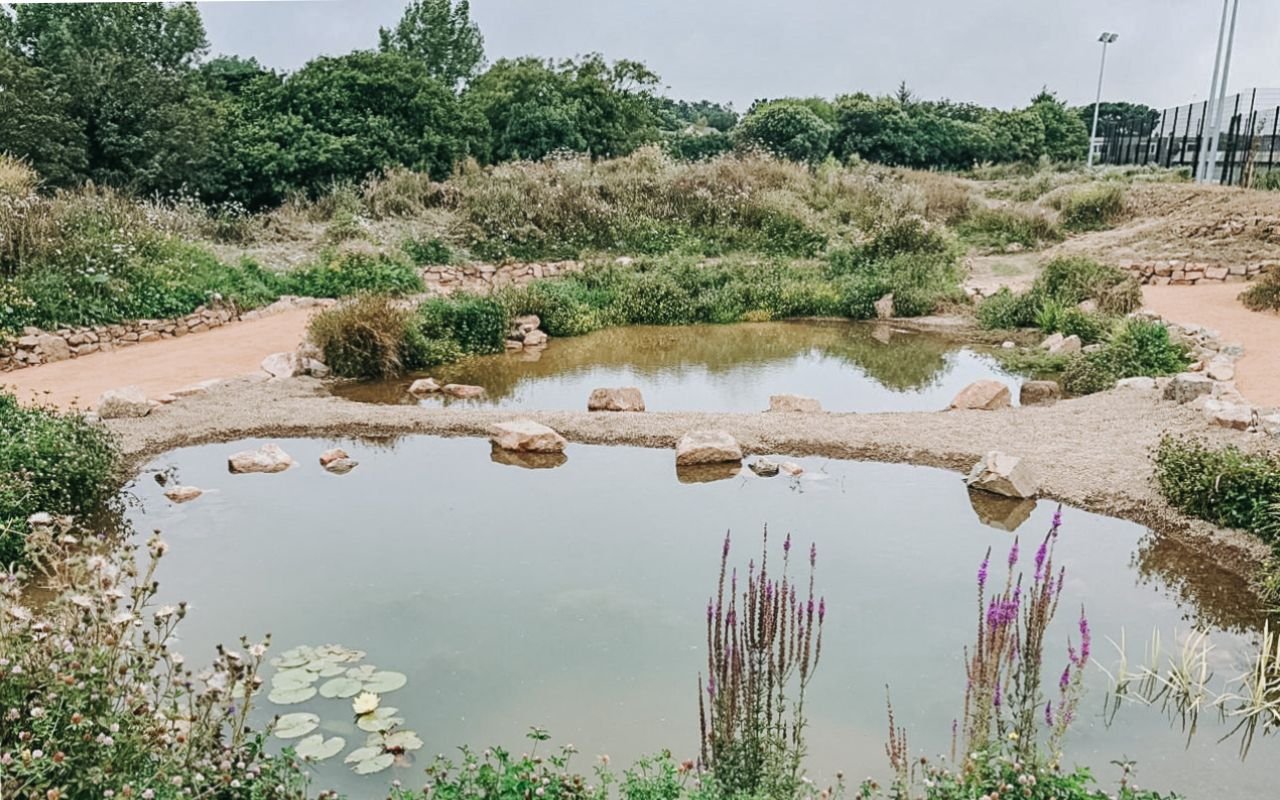Samarés Nurseries
Project Area
Ecology & Habitats
Specialisms
Mitigation/Protection, Environmental Gain, Habitat Creation
Year
2018
A large redundant glasshouse site with high populations of protected species groups present, successfully re-zoned for housing.
Breeding ponds for amphibians and large areas of rough grassland had to be removed, and the displaced animals re-homed to specially created receptor sites. This very large redundant glasshouse site had been left abandoned for 10 years and large areas of willow ‘woodland’ and rough grassland had become established which created favourable habitat for multiple species groups. Two large disused irrigation ponds were being used as breeding ponds for amphibians, and high populations of slow worms and birds had become established throughout the site.
The entire site was re-zoned for social housing, with the aim to get as many social houses as possible built on site to make the most of the space. At the same time the high diversity and population of protected wildlife needed to be accommodated for on-site during clearance and construction works, and features for their long term survival incorporated into the final design of the development. Highly invasive plant species were also present at this site and needed to be cleared and the soil treated carefully to prevent further spread.
Fortunately our client came to us at a very early stage of planning so that we could get our surveys done to help inform the design of the site well before Planning permission was sought, and we could work with the Department of the Environment to ensure a satisfactory Species Protection Plan could be implemented.
We worked closely with the client and design team to create and enhance an ecological ‘buffer zone’ around the periphery of the site, into which protected wildlife could be translocated prior to site clearance works, and this area will be maintained and managed in the long term. Protected wildlife was safeguarded in the short term, and suitable habitat created and maintained for their long-term survival in this area.
Short-term mitigation
This included timing of works to avoid nesting birds and breeding amphibians and reptiles.
An ecological buffer zone was established around the periphery of the site and enhanced with additional seeding of rough grassland, hedgerow planting, ‘hibernaculas’ and log piles and control of invasive plant species, etc.
These buffer zones were fenced with ‘exclusion fencing’ to prevent any animals translocated into these areas from re-entering the main works site, but allow connectivity and movement of animals into the wider countryside via already established wildlife corridors.
Two new wildlife ponds were created in the ecological buffer zone in advance of draining the irrigation ponds to ensure amphibian breeding habitat was maintained.
Clearance works were phased over an 18 month period to reduce the impact to wildlife, in line with the clients’ desired programme.
Large areas of the site were stripped under ecological supervision due to the high number of toads and slow worms within the main site – all animals were translocated to the receptor site under Licence from the Conservation of Wildlife (Jersey) Law 2000.
Long-term enhancements
The ecological buffer zone surrounding the periphery of the site will be maintained and managed in the long term, including the two wildlife ponds, rough grassland, native hedgerows, etc.
Ditches and areas of standing water maintained and enhanced around the periphery of the site as additional wetland habitat.
A green ‘wildlife corridor’ of favourable native trees and shrubs will be planted through the centre of the main site to facilitate the connectivity of this area for birds and bats.
Bat and bird boxes will be ‘built in’ to the external walls of the new houses to provide nesting / roosting habitats for these species
The site will be ‘permeable’ to the free movement of wildlife through the heart of site by providing access through / under all walls / fences on site.
Success
During trapping and translocation and ecological supervision of initial vegetation clearance works we translocated 116 slow-worms, 227 adult toads, approximately 600 juvenile toads, approximately 1500 tadpoles, 34 newts, and 19 small mammals into the ecological buffer zone surrounding the site.
The two wildlife ponds have already proven successful as breeding areas for toads, with many ‘toadlets’ found surrounding these areas. These ponds will be maintained and managed in the long term.
Large numbers of slow worms still found within the ecological buffer zone under our artificial ‘refugia’ mats.
Bat and bird roosting / nesting habitat incorporated into the new houses – success to be monitored following completion.
_____
Our client, Mark Le Boutillier, Director of GR Langlois said ‘Nurture Ecology has undertaken ecological works on several of our development sites. The Samares site was particularly challenging due to the size and diversity of the wildlife present. Nurture provided a structured method of clearing the site whilst protecting the wildlife which enabled us to continue the development on the planned programme. The Nurture team are very professional as well as being practical in understanding the need to keep the project moving forward. We have no hesitation in recommending Nurture Ecology to their other prospective clients and will no doubt be using their services on our future developments.’
Highlight Projects

















